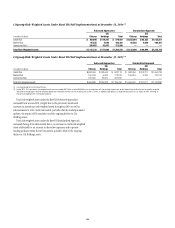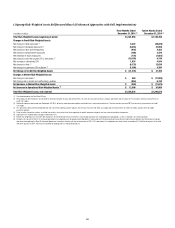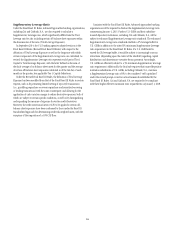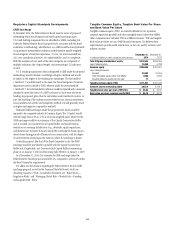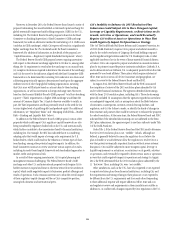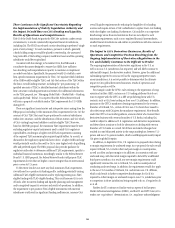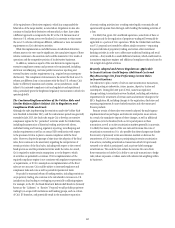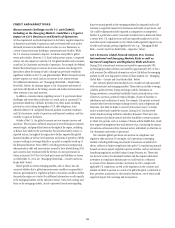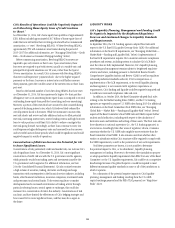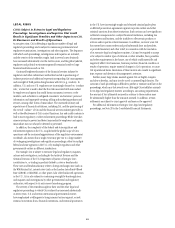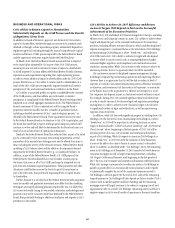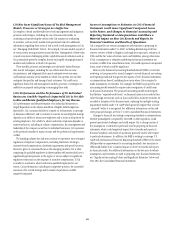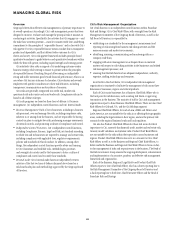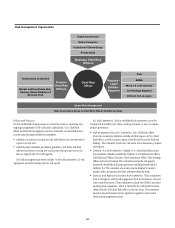Citibank 2014 Annual Report Download - page 76
Download and view the complete annual report
Please find page 76 of the 2014 Citibank annual report below. You can navigate through the pages in the report by either clicking on the pages listed below, or by using the keyword search tool below to find specific information within the annual report.59
Citi’s Results of Operations Could Be Negatively Impacted
as Its Revolving Home Equity Lines of Credit Continue
to “Reset.”
As of December 31, 2014, Citi’s home equity loan portfolio of approximately
$28.1 billion included approximately $16.7 billion of home equity lines of
credit that were still within their revolving period and had not commenced
amortization, or “reset” (Revolving HELOCs). Of these Revolving HELOCs,
approximately 78% will commence amortization during the period of
2015–2017 (for additional information, see “Managing Global Risk—Credit
Risk—North America Consumer Mortgage Lending” below).
Before commencing amortization, Revolving HELOC borrowers are
required to pay only interest on their loans. Upon amortization, these
borrowers are required to pay both interest, usually at a variable rate, and
principal that typically amortizes over 20 years, rather than the typical
30-year amortization. As a result, Citi’s customers with Revolving HELOCs
that reset could experience “payment shock” due to the higher required
payments on the loans. Increases in interest rates could further increase
these payments, given the variable nature of the interest rates on these loans
post-reset.
Based on the limited number of Citi’s Revolving HELOCs that have reset
as of December 31, 2014, Citi has experienced a higher 30+ days past due
delinquency rate on its amortizing home equity loans as compared to its total
outstanding home equity loan portfolio (amortizing and non-amortizing).
Moreover, a portion of the resets that have occurred to date occurred during
a period of declining interest rates, which Citi believes likely reduced the
overall payment shock to borrowers. While Citi continues to monitor this
reset risk closely and review and take additional actions to offset potential
reset risk, increasing interest rates, stricter lending criteria and high borrower
loan-to-value positions could limit Citi’s ability to reduce or mitigate this
reset risk going forward. Accordingly, as these loans continue to reset, Citi
could experience higher delinquency rates and increased loan loss reserves
and net credit losses in future periods, which could be significant and would
negatively impact its results of operations.
Concentrations of Risk Can Increase the Potential for Citi
to Incur Significant Losses.
Concentrations of risk, particularly credit and market risk, can increase Citi’s
risk of significant losses. As of December 31, 2014, Citi’s most significant
concentration of credit risk was with the U.S. government and its agencies,
which primarily results from trading assets and investments issued by the
U.S. government and its agencies (for additional information, see Note
24 to the Consolidated Financial Statements). Citi also routinely executes
a high volume of securities, trading, derivative and foreign exchange
transactions with counterparties in the financial services industry, including
banks, other financial institutions, insurance companies, investment banks
and government and central banks. To the extent regulatory or market
developments lead to increased centralization of trading activity through
particular clearing houses, central agents or exchanges, this could also
increase Citi’s concentration of risk in this industry. Concentrations of risk
can limit, and have limited, the effectiveness of Citi’s hedging strategies and
have caused Citi to incur significant losses, and they may do so again in
the future.
LIQUIDITY RISKS
Citi’s Liquidity Planning, Management and Funding Could
Be Negatively Impacted by the Heightened Regulatory
Focus on and Continued Changes to Liquidity Standards
and Requirements.
In September 2014, the U.S. banking agencies adopted final rules with
respect to the U.S. Basel III Liquidity Coverage Ratio (LCR) (for additional
information on the final LCR requirements, see “Managing Global Risk—
Market Risk—Funding and Liquidity Risk” below). Implementation of
the final LCR requirements requires Citi to maintain extensive compliance
procedures and systems, including systems to calculate Citi’s LCR daily
once the rules are fully implemented. Moreover, Citi’s liquidity planning,
stress testing and management remains subject to heightened regulatory
scrutiny and review, including pursuant to the Federal Reserve Board’s
Comprehensive Liquidity Analysis and Review (CLAR) as well as regulators’
enhanced prudential standards authority. If Citi’s interpretation or
implementation of the LCR requirements, or its overall liquidity planning
and management, is not consistent with regulatory expectations or
requirements, Citi’s funding and liquidity could be negatively impacted and
it could incur increased compliance risks and costs.
In addition, in October 2014, the Basel Committee adopted final rules
relating to the Net Stable Funding Ratio (NSFR), and the U.S. banking
agencies are expected to propose U.S. NSFR rules during 2015 (for additional
information on the Basel Committee’s final NSFR rules, see “Managing
Global Risk—Market Risk—Funding and Liquidity Risk” below). Several
aspects of the Basel Committee’s final NSFR rules will likely require further
analysis and clarification, including with respect to the calculation of
derivative assets and liabilities and netting of these assets. The final rules also
leave discretion to national supervisors (i.e., the U.S. banking agencies) in
several areas. Accordingly, like other areas of regulatory reform, it remains
uncertain whether the U.S. NSFR rules might be more restrictive than the
Basel Committee’s final NSFR. It also remains uncertain whether other
entities or subsidiaries within Citi’s structure will be required to comply with
the NSFR requirements, as well as the parameters of any such requirements.
Until these parameters are known, it is not possible to determine
the potential impact to Citi’s, or its subsidiaries’, liquidity planning,
management or funding. Moreover, to the extent other jurisdictions propose
or adopt quantitative liquidity requirements that differ from any of the Basel
Committee’s or the U.S. liquidity requirements, Citi could be at a competitive
disadvantage because of its global footprint or could be required to meet
different minimum liquidity standards in some or all of the jurisdictions in
which it operates.
For a discussion of the potential negative impacts to Citi’s liquidity
planning, management and funding resulting from the U.S. GSIB
capital surcharge proposal and the FSB’s TLAC proposal, see “Regulatory
Risks” above.


